Warendorf is a Kreis (district) in the northern part of North Rhine-Westphalia, Germany. Neighboring districts are Steinfurt, Osnabrück (district), Gütersloh, Soest, district-free city Hamm, Coesfeld and the district-free city Münster.
Gütersloh is a Kreis (district) in the north-east of North Rhine-Westphalia, Germany. Neighboring districts are Osnabrück, Herford, district-free Bielefeld, Lippe, Paderborn, Soest and Warendorf.

Horstmar is a German town, located in North Rhine-Westphalia in the Steinfurt district, approx. 25 km (16 mi) north-west of Münster.

Extertal is a municipality in the Lippe district of North Rhine-Westphalia, Germany, with c. 11,500 inhabitants (2013).

Delbrück is a town in the east of North Rhine-Westphalia, Germany, located in the district Paderborn.

Euskirchen is a town in North Rhine-Westphalia, Germany, capital of the district Euskirchen. While Euskirchen resembles a modern shopping town, it also has a history dating back over 700 years, having been granted town status in 1302. As of December 2007, it had a population of 55,446. Its local football club is called TSC Euskirchen.

Warendorf is a town in North Rhine-Westphalia, Germany, and capital of Warendorf District.

Meerbusch is a town in Rhein-Kreis Neuss, North Rhine-Westphalia, Germany. It has been an incorporated town since 1970. Meerbusch is the municipality with the most income millionaires in North Rhine-Westphalia.
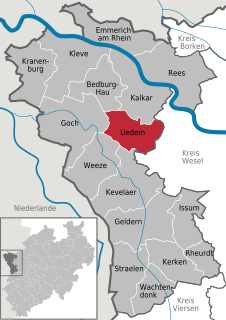
Uedem is a municipality in the district of Cleves, in North Rhine-Westphalia, Germany. It is located near the border with the Netherlands.

Raesfeld is a municipality in the district of Borken in the state of North Rhine-Westphalia, Germany. It is located approximately 10 km south of Borken and 30 km east of the Dutch border.

Harsewinkel is a town in Gütersloh District in the state of North Rhine-Westphalia, Germany. It lies on the river Ems, some 15 km north-west of Gütersloh.

Rheda-Wiedenbrück is a city in the district of Gütersloh, in North Rhine-Westphalia, Germany.
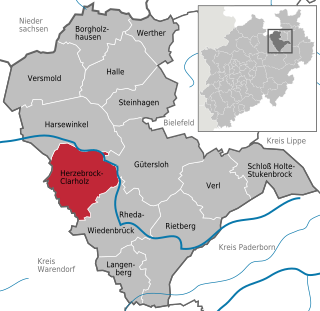
Herzebrock-Clarholz is a town in the district of Gütersloh in the state of North Rhine-Westphalia, Germany. It is located approximately 10 km west of Gütersloh.
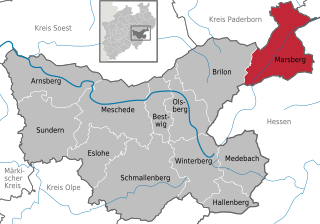
Marsberg is a town in the Hochsauerland district, in North Rhine-Westphalia, Germany.
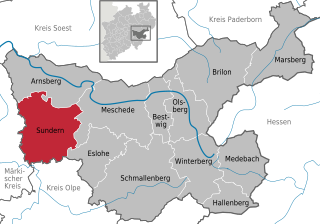
Sundern is a town in the Hochsauerland district, in North Rhine-Westphalia, Germany. The name Sundern is common in Westphalia, as it means "ground given away for private usage" in the Westphalian dialect.
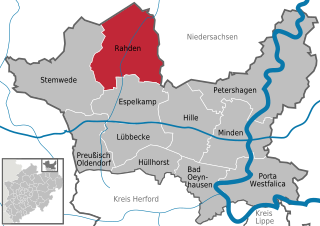
Rahden is a town in the far north of North Rhine-Westphalia between Bielefeld and Bremen and between Hanover and Osnabrück. Rahden is part of the Minden-Lübbecke District in East Westphalia-Lippe.

Oer-Erkenschwick is a town in the district of Recklinghausen, in North Rhine-Westphalia, Germany. It is situated approximately 5 km north-east of Recklinghausen, on the northern periphery of the Ruhrgebiet. When pronouncing the name, “Oer” should be pronounced like the German Ohr, not Ör.

Lippetal is a municipality in the district of Soest, in North Rhine-Westphalia, Germany.

Beckum is a town in the northern part of North Rhine-Westphalia, Germany. It is about 20 km north-east of Hamm and 35 km south-east of Münster. It gives its name to the nearby Beckum Hills.

Sendenhorst is a town in the district of Warendorf, in North Rhine-Westphalia, Germany. It is situated approximately 20 km (12 mi) north of Hamm and 20 km (12 mi) south-east of Münster.


























